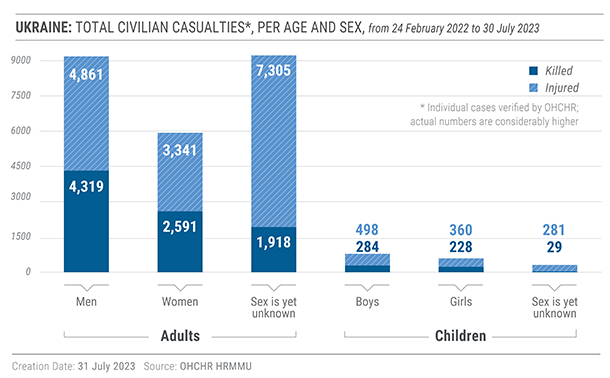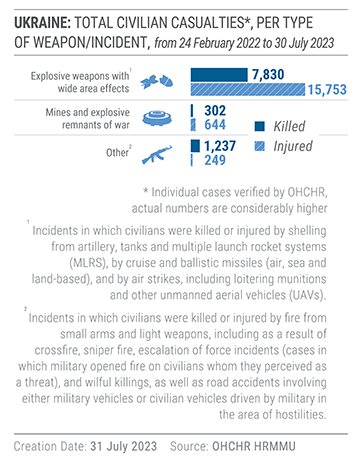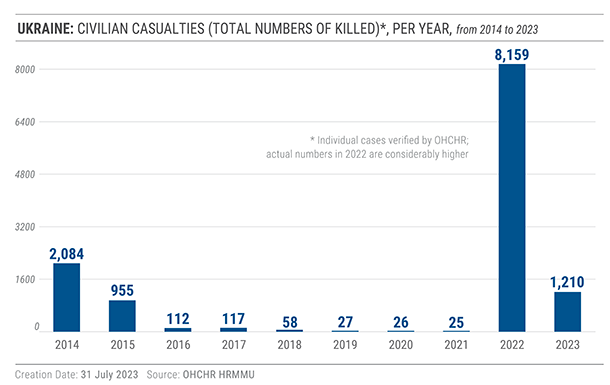News Office of the High Commissioner for Human Rights
Ukraine: civilian casualty update 31 July 2023
31 July 2023
Date: 31 July 20231
Civilian casualties from 1 to 30 July 2023
From 1 to 30 July 2023, Office of the UN High Commissioner for Human Rights (OHCHR) recorded 748 civilian casualties in Ukraine:
- 143 killed (77 men, 56 women, 2 boys, 2 girls, as well as 6 adults whose sex is not yet known), and
- 605 injured (239 men, 221 women, 20 boys, 15 girls, as well as 102 adults whose sex is not yet known).
This included:
- 125 killed (68 men, 47 women, 2 boys, 2 girls, as well as 6 adults whose sex is not yet known) and 536 injured (205 men, 189 women, 20 boys, 12 girls, as well as 8 children and 102 adults whose sex is not yet known) in 137 settlements in territory controlled by the Government when casualties occurred (88 percent of the total), and
- 18 killed (9 men, 9 women) and 69 injured (34 men, 32 women and 3 girls) in 14 settlements in territory occupied by the Russian Federation when casualties occurred (12 percent of the total).
Per type of weapon/incident:
- Explosive weapons with wide area effects: 138 killed and 577 injured (96 per cent):
- 633 casualties (120 killed and 513 injured) in territory controlled by the Government when casualties occurred, and
- 82 casualties (18 killed and 64 injured) in territory occupied by the Russian Federation when casualties occurred.
- Mines and explosive remnants of war: 5 killed and 20 injured (4 per cent):
- 28 casualties (5 killed and 23 injured) in territory controlled by the Government when casualties occurred, and
- 5 injured in territory occupied by the Russian Federation when casualties occurred.
Total civilian casualties
From 24 February 2022, which marked the start of the large-scale armed attack by the Russian Federation, to 30 July 2023, OHCHR recorded 26,015 civilian casualties in the country: 9,369 killed and 16,646 injured. This included:
- 21,008 casualties (7,283 killed and 13,725 injured) in territory controlled by the Government when casualties occurred:
- In Donetsk and Luhansk regions: 10,246 casualties (4,184 killed and 6,062 injured); and
- In other regions[2]: 10,762 casualties (3,099 killed and 7,663 injured).
- 5,007 casualties (2,086 killed and 2,921 injured) in territory occupied by the Russian Federation when casualties occurred:
- In Donetsk and Luhansk regions: 3,399 casualties (758 killed and 2,641 injured); and
- In other regions[3]: 1,608 casualties (1,328 killed and 280 injured).

OHCHR believes that the actual figures are considerably higher, as the receipt of information from some locations where intense hostilities have been going on has been delayed and many reports are still pending corroboration. This concerns, for example, Mariupol (Donetsk region), Lysychansk, Popasna, and Sievierodonetsk (Luhansk region), where there are allegations of numerous civilian casualties.



The UN Human Rights Monitoring Mission in Ukraine
Since 2014, OHCHR has been documenting civilian casualties in Ukraine. Reports are based on information that the UN Human Rights Monitoring Mission in Ukraine (HRMMU) collected through interviews with victims and their relatives; witnesses; analysis of corroborating material confidentially shared with HRMMU; official records; open-source documents, photo and video materials; forensic records and reports; criminal investigation materials; court documents; reports by international and national non-governmental organisations; public reports by law enforcement and military actors; data from medical facilities and local authorities. All sources and information are assessed for their relevance and credibility and cross-checked against other information. In some instances, corroboration may take time. This may mean that conclusions on civilian casualties may be revised as more information becomes available and numbers may change as new information emerges over time. Statistics presented in the current update are based on individual civilian casualty records where the “reasonable grounds to believe” standard of proof was met, namely where, based on a body of verified information, an ordinarily prudent observer would have reasonable grounds to believe that the casualty took place as described.
ENDS
Ukrainian and Russian language versions of this update as they become available, please visit this page.
[1] An increase in figures in this update compared with the previous update (as of 16 July 2023) should not be attributed to civilian casualties that occurred from 17 to 30 July 2023 only, as during these days OHCHR also corroborated casualties that occurred on previous days. Similarly, not all civilian casualties that were reported from 17 to 30 July 2023 have been included into the above figures. Some of them are still pending corroboration and if confirmed, will be reported on in future updates.
[2] The city of Kyiv, and Cherkasy, Chernihiv, Ivano-Frankivsk, Kharkiv, Kherson, Kirovohrad, Kyiv, Mykolaiv, Odesa, Sumy, Zaporizhzhia, Dnipropetrovsk, Khmelnytskyi, Lviv, Poltava, Rivne, Ternopil, Vinnytsia, Volyn, and Zhytomyr regions.
[3] Chernihiv, Kharkiv, Kherson, Kyiv, Mykolaiv, Sumy, and Zaporizhzhia regions.
For more information and media requests, please contact:
Liz Throssell: + 41 22 917 9296 / elizabeth.throssell@un.org or
Marta Hurtado: + 41 22 917 9466 / marta.hurtadogomez@un.org
Tag and share
Twitter @UNHumanRights
Facebook unitednationshumanrights
Instagram @unitednationshumanrights